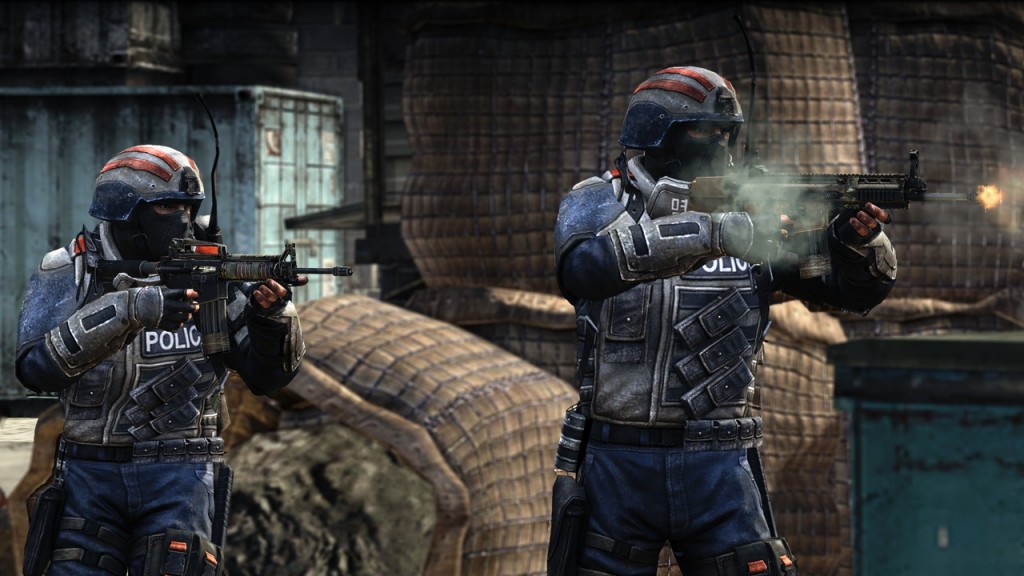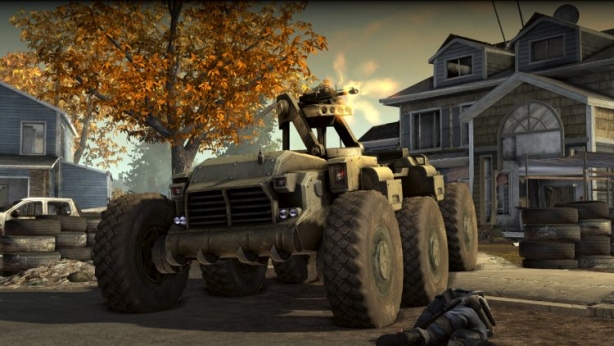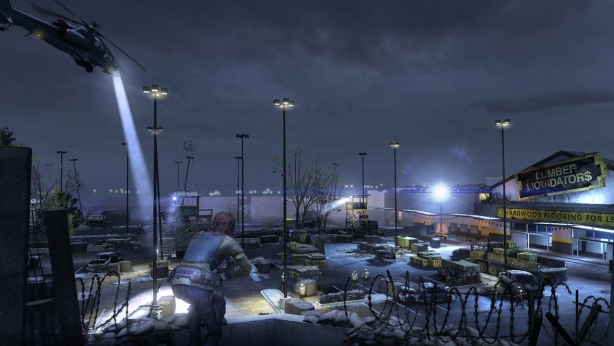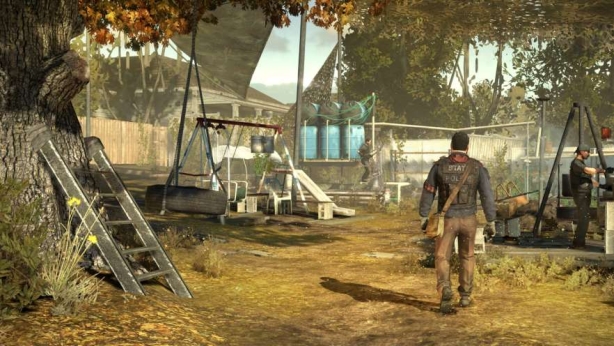Homefront Review
Developer: Kaos Studios
Publisher: THQ
Available on: Xbox 360, PlayStation 3 and PC (Xbox 360 version reviewed)
Home is where the war is, that is what the marketing campaign for Homefront would have you believe. With a rich tapestry of fiction behind it (including a novel by John Milius), Homefront creates an entirely new world for the player to experience. A world that has hidden connotations alluding to a possible future full of anguish and pain, reminding us all that we are never safe from the people who would choose to forcibly remove our freedom.
Homefront is also a first person shooter, of which there are a genuine bounty to choose from. The likes of Killzone 3, Halo and Call of Duty have not only captured people’s imaginations when it comes to gameplay, but story as well. Should you care about Homefront? Is it vital? Read on to find out.
STORY: Kim Jong-Il is dead, his son Kim Jong-Un has taken over and somehow managed to unite North and South Korea, as well as annexing Japan and many surrounding nations. Horrifyingly, the United Korean Republic have managed to force the US army to withdraw from anywhere close to Korea, and have themselves managed to convince their previous enemies that they are harmless. America is in a harsh economic downfall, none of the Asian countries will deal with them and therefore certain commodities (gas/petrol) are in short supply, with prices rocketting to $20 a gallon.
Eventually, the true nature of Kim Jong-Un’s plans come to fruition and an EMP is lauched from a (thought to be safe) satellite, pretty much wiping out the entirety of the United States’ defenses, allowing the Korean army to infiltrate the States and take over.
This is actually explained before you even take control of the lead character, Jacobs, in 2027. All of this is before your door is kicked down and you are siezed by Korean soldiers for non-compliance. The media is now Korean, the economy is destroyed, the US is all but a wasteland and now you are taken away on a bus to God only knows where. This is where Homefront’s true story begins to unravel and some of the scenes you will witness are the likes of things never seen in a game before. Brutal, horrendous, upsetting scenes. Homefront does not dodge any bullets, it is violent and, at times, it is also genuinely upsetting.
The effort made to create the fiction for Homefront should truly be applauded, with a novel entitled “The Voice of Freedom” that actually plays out in the title and scattered literature throughout the enviroment, the fiction is seriously deep. Reading the novel is actually reccomended, as it not only gives you a better understanding how everything came to be so horrific, but because it is actually a decent read. One short word of caution however, don’t go into Homefront expecting to get a totally self contained story, wrapped up with a solid conclusion. This title has almost certainly been designed with a view to a future as a franchise, as is evedent by the fiction in the aforementioned novel and the short story in this game.
GRAPHICS: Whilst Homefront never comes close to hitting the high points of first person shooter royalty (the Killzone’s of the industry), it does manage to “wow” the player at numerous occasions. Whether this be through simple explosions, which are rendered extremely well, or through the situations you end up in due to the nature of the environment. There are truly some moments that you may never forget and, once again, Homefront is to be applauded for this.
Lip-syncing gets a special mention, as it is very well done indeed, and despite some of the character models (especially the faces of non-playable characters) not looking particularly special, they get the job done. Weapon and vehicle models are superb though, you can tell they have had some extra attention lavished upon them, much like the mighty impressive destroyed vistas and tortured skies.
There are a few odd choices though, such as “Press A To Skip” being ever-present during some cut-scenes, obscuring some of the artwork on show whilst “The Voice of Freedom” conducts his pirate radio broadcast. It’s a shame, and quite peculiar, that this happens as the depth of fiction on display with the still images deserves to be seen. It’s not a game-breaker, but it does slightly effect the level of immersion.
SOUND: Just like the lip-syncing, the voice acting is also very well done. Believable and passionate, you will very quickly grow attached to the characters throughout. They all have personalities and you can talk to most NPC’s that are in the non-combat sections of the game. Some of them even throwing jokes at you, such as a goat-herder telling you he is worried about the attention you are giving his goats.
The combat sounds fantastic and the chatter taking place from both sets of soldiers is constant and immersive. Occasional overlapping can occur with the voice acting, but it’s really not that prevalent.
GAMEPLAY: Straddling the fence between realistic and arcade, Homefront leans more towards the Call of Duty (Modern Warfare mainly) side of shooter mechanics. You can run and gun if you want, but you will also be rewarded for more deliberate movement. The weaponry handles extremely well, with headshots a dream to pull off.
Due to the destroyed state of America that the title takes place in, you’ll never have the same gun for very long. Ammunition is scarce and the Korean soldiers use a variety of weapons. You can carry two weapons at time, be it a combination of handgun and shotgun, sniper rifle and heavy machine gun, or simply two automatic rifles. You can also carry grenades and C4, whilst having a knife as backup, used with a simple click of the right stick.
In addition to the usual weaponry, Homefront also includes a Korean vehicle called Golliath that you can control via a scope. It’s a blast to use and not only does it allow you to target multiple enemy soldiers, you can take out vehicles as well. Hell, if you’re quick enough, even taking out helicopters is a breeze. The Golliath isn’t available at all times though, it’s only rolled out at story specific moments. At other points in the game you will also control a helicopter and man a few gun turrets, it’s all part of the fun and it all feels great!
Outside of the combat sections, Homefront feels deliberately slow. This forces you to take in your surroundings and, at times, see the sheer horror on display. You can interact with people by hitting the “X” button to talk to them, this usually involves a few lines of dialogue, but most of the time you are told to get lost as the resistance is perceived to be a bunch of troublemakers.
During combat though, it is pretty quick paced and the enemies drop in a satisfying manner. That being said, they are certainly not bullet sponges on the “normal” difficulty level. Overall, the bulk of the single player campaign feels very satisfying indeed and set pieces never outstay their welcome, staying just the right side of the over-the-top. There are a few odd bugs though, including the occasional sight of enemies suddenly appearing from nowhere and on one mission there seemed to be a bug that wouldn’t allow you to progress until you restarted the checkpoint. Moreover, the game is extremely scripted, not allowing you to climb ladders or progress until you move out of the way and let the AI characters do their thing first! Later on in the game there is some very occasional slowdown and you might (admittedly rarely) see characters slightly clip through things sometimes.
MULTIPLAYER: Upon first inspection, Homefront seems not to stray too far from the traditional Call of Duty style multiplayer and, fundamentally, that is what it pays homage to. However, upon picking a loadout, each class has two special abilities, be it a helicopter style drone or a simple remote controlled vehicle. You can’t just whip these out at will though and start dominating, you’ll have to “buy them” mid-match.
These abilities cost battle points, which you earn by killing people or completing objectives. It’s a simple equation, kill numerous opponents or complete multiple objectives and you’ll earn a high number of battle points, which in turn will allow you to use more of your abilities and gadgets. Battle points also allow you to spawn with different vehicles, which become more powerful as you level up through the rankings. The entire battle points idea is a superb leveller. It doesn’t matter if you’ve only played for 2 hours and are up against people who have spent 48 hours of their lives on it, you all start with the same battle points.
At first it all seems a little overwhelming, but if that is the case, you can just stick to the 24 man team deathmatch mode. This mode is far more friendlier than the others, such as the Homefront version of capture the zone, which entails taking over one of three zones to gain points. As the match wears on, both teams have a bar which is filled by taking over more zones, over and over. Eventually the bar will become full and you win the round, two rounds win the match.
New to the genre is an intruiging way of rooting out those oh so irritating campers! In “Battle Commander” mode, if someone is getting a lot of kills, they will be identified on the map, allowing people to root them out and get rid of them for a few seconds. Of course, this will be a huge annoyance to those campers, but it also gives a tangible reward of knowing if someone is truly skilled! It might seem an unfair punishment to the people who are just good at the game, but it gives other people a chance and lets the rest of the players know who the best player in the virtual battlefield is.
At low levels, encountering someone with a helicopter can be a frustrating experience, as taking them down without homing weaponry is difficult. This might mean you getting dominated at first, but thankfully the learning curve is relatively short so you shouldn’t be getting hammered for too long. The maps are mostly large, varied in their environments allowing for snipers, vehicles and indoor close quarters combat. All styles of gameplay are catered for on the online battlefield in Homefront, therefore pretty much anyone can get into the groove after a couple of hours play and that is something you would be hard pressed to say about other online shooters.
LONGEVITY: Sadly, the Homefront single player campaign is extremely short. On the normal difficultly level, don’t expect the singe player to take much longer than 5-6 hours. Toward the end of the campaign, the difficult spikes quite severely in a manner that brings to mind the final push from Killzone 2. This adds a bit of length and if you wanted to play through on the hardest difficulty, this would greatly increase the time it’d take to complete whilst simultaneously increasing the frustration levels significantly.
There are over 60 collectibles to find throughout the single player, but there is no way of knowing how many you have or how many are left to find on each level. Therefore, if you want to grab the achievements for the collectibles, be prepared to spend a lot of time searching every nook and cranny of every single level.
With that in mind, it’s a good thing that the multiplayer is so deep and allows you to level up to 50, which should take you some time. The multiplayer is excellent and brings in some really intruiging prospects that stop campers and root out the truly skillful players. If you enjoy online first person shooters, Homefront will keep you busy for a very long time.
VERDICT: Homefront puts the player in situations most people won’t have experienced in a game before, it shows you things you can’t unsee and is graphic in its delivery of the enemy brutality. You will feel the restistance’s struggle and you will care. The shooter mechanics feel excellent and the story is one worth hearing.
The Homefront multiplayer is a fine alternative to the other shooters out there, sitting comfortably somewhere between Call of Duty and Battlefield respectively, whilst retaining enough of a similarity that you won’t feel put off by ground breaking new mechanics.
Is this a shocking glimpse of the future? Probably not, but Homefront has created a rich world that numerous stories could be told within and, as such, is a worthy addition to anyone’s collection, just don’t expect to still be playing it in 6 months time.










